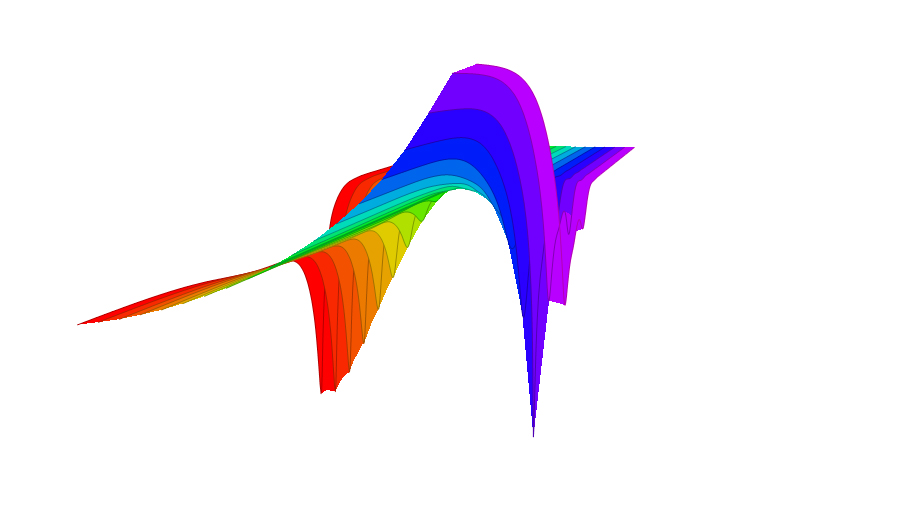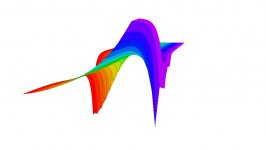Is SQ sound quality?
Discussions of sound quality in homes revolve around frequency response and directivity index. You can get there with high or low sensitivity drivers.
Discussions of sound quality in homes revolve around frequency response and directivity index. You can get there with high or low sensitivity drivers.
That speaker seems to encourage wide dispersion. At some frequencies this is taking diffraction, which is also near the source.about how this speaker here was low efficiency crap.
Another reason this speaker may be different is the crossover philosophy.
No non-linear distortion.so minimum phase eq has non linear distortions....resulting in group delay.
What do all high sensitivity speakers have in common? - very low moving mass ( in relation to sound output ) compared to low sensitivity speakers, is it the much reduced vibration transmitted to the cabinet through the basket of the driver/drivers that results in a cleaner, better sound?
This conversation seems to have been premised on the assumption that high efficiency DOES equate to higher sound quality.
I am unconvinced. I have heard high efficiency speakers that sound very good, but some of the very best I have ever heard have been moderate efficiency.
Maybe this alleged preference for high sensitivity is actually a preference for a controlled (narrow) directivity. I can not think of a high sensitivity speaker that is not also a controlled directivity speaker....
One thing is certain, with a low sensitivity speaker, you really do need a high power, high current amplifier.
I am unconvinced. I have heard high efficiency speakers that sound very good, but some of the very best I have ever heard have been moderate efficiency.
Maybe this alleged preference for high sensitivity is actually a preference for a controlled (narrow) directivity. I can not think of a high sensitivity speaker that is not also a controlled directivity speaker....
One thing is certain, with a low sensitivity speaker, you really do need a high power, high current amplifier.
H.E. allows a higher SQ potential.
GM
Hi GM, i agree, for the reason I've given.
May i ask why you think so?
Thanks for the replies and allowing me to play devils advocate on what I think is a somewhat controversial topic. I like the idea of taking impulse/step response measurements at different levels, as well as, taking FR at high level duration....I can't be first to think of it but I like to fancy the idea...Just like QTS is measured at fs, but is only snap shot of the performance at one stage out of many (because Q changes with frequency)...IR and step are checked at 1watt but this too is just a snap shot and this variable changes with magnitude.
I'd really like for us to start benchmarking systems using this metric...I don't know if anyone will entertain me...even if just out of curiosity. If you think about it, IR/Step at one watt is removed from what one might here during a listening session. Taking a IR/Step measurement at desired listening level (90db for example) is an interesting measurement if you ask me....and just like polar measurement can displayed in VituixCad as a cascading line graph, I'd like to see something similar become programing in software that we can see the IR/Step response shape shift from 1watt and increasing....if we can name it after me, even better lol
1watt, take snap shop, 10 watt take snap shop, 20 watt, 30watt, so on and so on....then display the shapes cascading in 3d, from origin to final sorta like this

I'd really like for us to start benchmarking systems using this metric...I don't know if anyone will entertain me...even if just out of curiosity. If you think about it, IR/Step at one watt is removed from what one might here during a listening session. Taking a IR/Step measurement at desired listening level (90db for example) is an interesting measurement if you ask me....and just like polar measurement can displayed in VituixCad as a cascading line graph, I'd like to see something similar become programing in software that we can see the IR/Step response shape shift from 1watt and increasing....if we can name it after me, even better lol
1watt, take snap shop, 10 watt take snap shop, 20 watt, 30watt, so on and so on....then display the shapes cascading in 3d, from origin to final sorta like this
Attachments
Last edited:
You seem to be suggesting that the response will be flat at the lowest levels, resembling the test signal. Were you just 'playing devils advocate'?If I could provide you a graph it would show the Impulse/step response at each interval, 1watt all the way to max desired test wattage...this graph will expose what happens when the transient starts losing its original benchmark shape of 1watt. Smoking what I'm putting down?
I am suggesting the IR/STEP response will not be the same at (>1watt or <1watt) vs (1watt)
And that this measurement taken at a level resembling desired listening level...may be of use?
And the characteristical change we witness from low level to higher level input may also be of use?
And that this measurement taken at a level resembling desired listening level...may be of use?
And the characteristical change we witness from low level to higher level input may also be of use?
Last edited:
Nope, still not convinced. I think back to the now famous double blind listening session where a JBL M2 faced off against a Revel Salon 2. Most people thought the M2 would be the winner, but approximately 70% of the listeners preferred the Revel.
Then there is Patrick Batemans recent thread about why we prefer direct radiator systems.
The Preference for Direct Radiators
This is an area where we can agree to disagree. I know what characteristics I look for in a speaker, I know what makes a speaker "disappear" in the room (for me). High efficiency is nice to have, but it is not (for me) one of the crucial characteristics.
Then there is Patrick Batemans recent thread about why we prefer direct radiator systems.
The Preference for Direct Radiators
This is an area where we can agree to disagree. I know what characteristics I look for in a speaker, I know what makes a speaker "disappear" in the room (for me). High efficiency is nice to have, but it is not (for me) one of the crucial characteristics.
Imagine the IR of a driver with 100db sens, tested at 90db vs a driver with 85db sens tested at 90db (all other things being equal or logical?).... anything unique happen? Too many variables to see a trend?
lets say at one watt both drivers have an equal IR....at 90db.... do we see a trend?
lets say at one watt both drivers have an equal IR....at 90db.... do we see a trend?
Last edited:
Nope, still not convinced. I think back to the now famous double blind listening session where a JBL M2 faced off against a Revel Salon 2. Most people thought the M2 would be the winner, but approximately 70% of the listeners preferred the Revel.
Then there is Patrick Batemans recent thread about why we prefer direct radiator systems.
The Preference for Direct Radiators
A quote from the first post in the thread lol
They (Horns) can sound great with great recordings, but with bad recordings they sound mono.
So 70% of those people want to be lied too.... This isn't helping your argument lol. Slightly Joking...I remember what I took away from blind test was that the more professional listeners preferred higher directivity and neutrality.
Last edited:
Impulse response, frequency response.. what's the diff? The question is what difference will there be, are you talking about harmonic distortion or something else?I am suggesting the IR/STEP response will not be the same at (>1watt or <1watt) vs (1watt)
You just said it.
I guess I am focusing in on the deviation of Fr from 1watt to desired listening level...in a detailed way. Looking at the IR is more telling for me than looking at the FR
the difference we see in the "graph" from 1watt to desired level is the meat. Its the same as measuring FR at multiple levels is what you are telling me I guess...The question is what difference will there be
I guess I am focusing in on the deviation of Fr from 1watt to desired listening level...in a detailed way. Looking at the IR is more telling for me than looking at the FR
Last edited:
I'm trying to tell not too much until I see a question (Weren't you telling the story?).is what you are telling me I guess...
Yes, what you are saying is that the frequency response will be the same, or different at different levels. You are suggesting this relationship varies with driver efficiency.
What happens in each case? The motor takes less power to do the same thing. So what things will that affect?
P.S. Incidentally, I'm reminded of the theoretical discussion on thermal modulation (like compression only instantaneous in effect) a little while back. Some of us already seemed to have an effect we were attributing to this as yet unknown phenomena, but not much ended up coming of it.
Last edited:
I'm not sure if there is a question lol you haven't stopped me in my tracks yet so I must be discovering some truths.
Does electrical resistance and inductance increase as input increases? Mechanical resistance increases with excursion....Mechanical Inductance increases with mass and velocity?....
You are asking the questions I should ask lol....I take it you already know the answer?What happens in each case? The motor takes less power to do the same thing. So what things will that affect?
Does electrical resistance and inductance increase as input increases? Mechanical resistance increases with excursion....Mechanical Inductance increases with mass and velocity?....
Last edited:
You can lead a horse to water 😉.. No, I'm not certain I have all the answers.You are asking the questions I should ask lol...
A conventional light bulb is likely to blow when you first switch it on as metals tend to have lower resistance when they are cold, something that very much affects speakers. Maybe you've heard it, at different volumes the tonal balance between ways changes as one of the drivers heats up.
Regarding your connection with mass.. this is obviously a design time choice, which is then fixed. Efficient drivers tend to have light cones, but they don't have to. There are other ways to raise efficiency.. So that avenue of questioning forks here.
A raw impulse response is dominated by high frequencies and is not that easy to interpret without filtering or transforming into something else.Looking at the IR is more telling for me than looking at the FR
Many people have measured drivers at different drive levels, the frequency response is always very similar until some sort of compression sets in.
"They (Horns) can sound great with great recordings, but with bad recordings they sound mono. "
Utter rubbish.
Utter rubbish.
+1, or maybe +2Utter rubbish.
As I say, this is an area where we can legitimately disagree. Many people will prefer direct radiator systems (which tend to be moderate to low sensitivity and have a wide dispersion pattern), while many other people will prefer horn/WG systems (which tend to be high sensitivity and more narrow dispersion).
My theory is that people who like horn/WG systems prefer the sound of a narrow and controlled dispersion pattern. It is not the efficiency that gives them "that sound", it is the directivity.
- Home
- Loudspeakers
- Multi-Way
- Higher Sensitivity/Efficiency vs SQ
